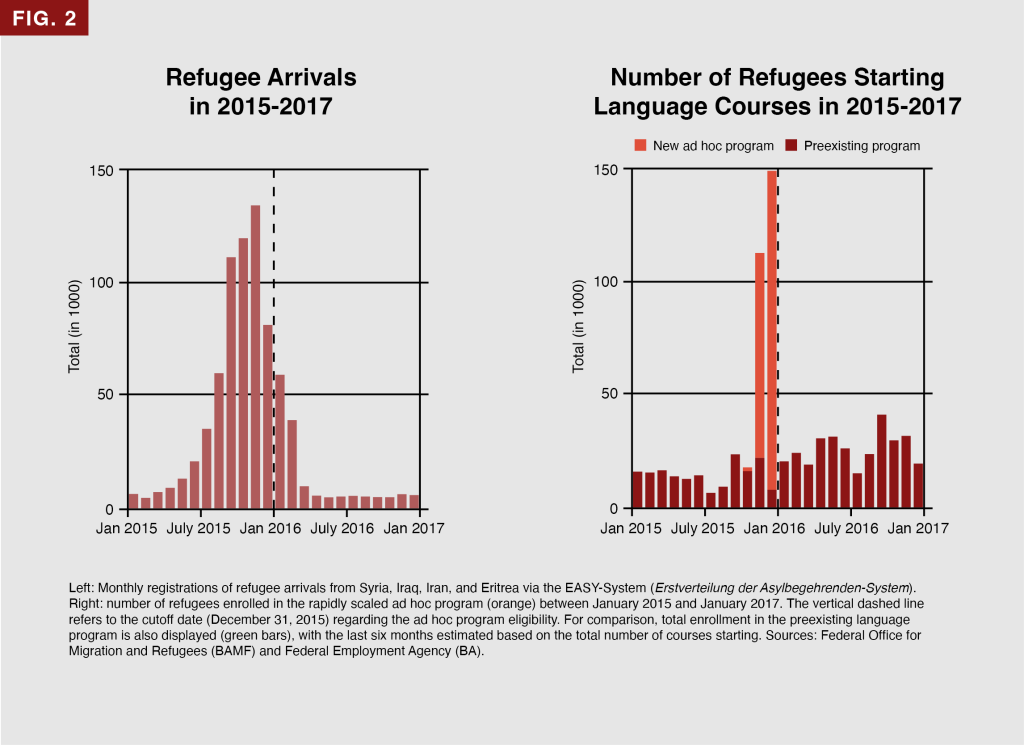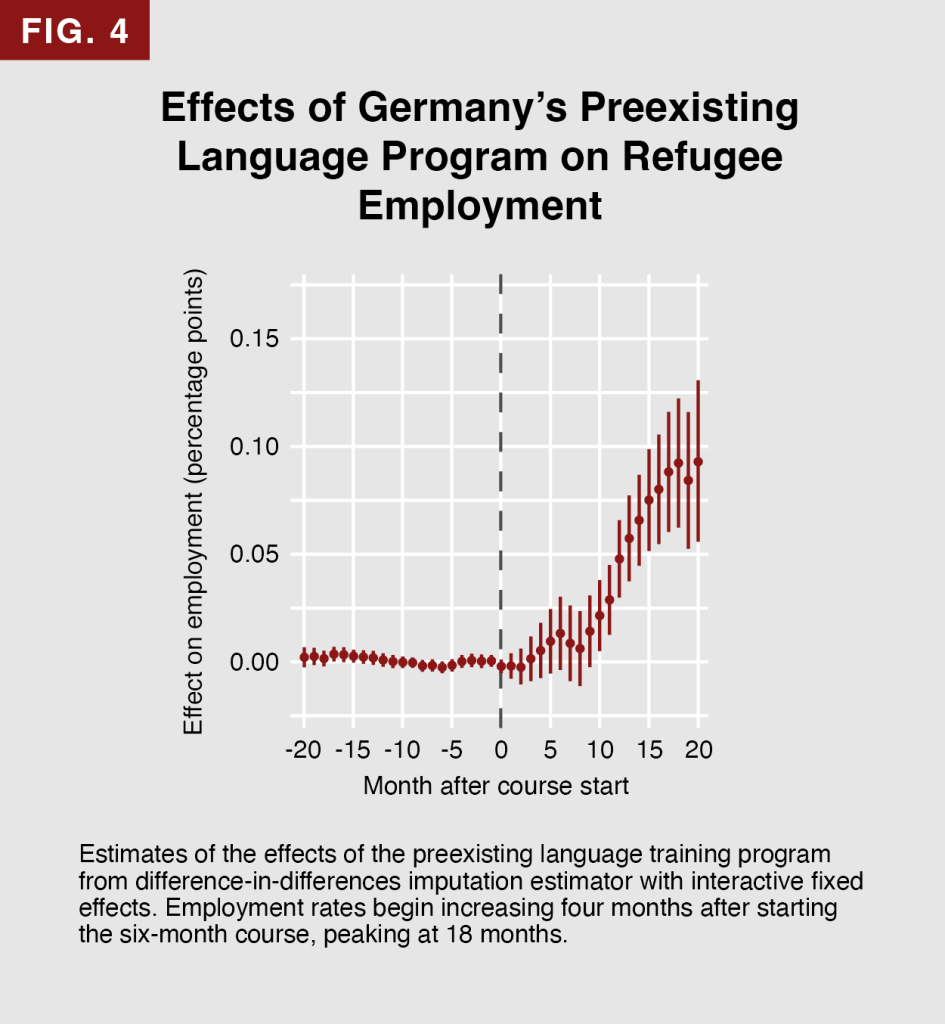
In 2015, as vast numbers of refugees entered Europe, Germany’s government scrambled to respond. One of the best ways for newcomers to find stability and integrate into a new country is often through a job. Yet for hundreds of thousands of people arriving from North Africa and the Middle East, getting a job required learning German, which presented a significant hurdle. Established language training programs that Germany offered foreigners quickly reached capacity, forcing policymakers to devise an alternative. Their solution was the Introductory German Language Course (Einstiegskurs zur Deutschförderung), an ad hoc, accelerated language course designed to accommodate a large number of refugees primarily coming from Syria, Iraq, Iran, and Eritrea. Looking at enrollment, this ambitious response was successful: around 230,000 refugees, or about 38 percent of the population that arrived in 2015, took the course. But what effect did the temporary language program have for refugees, particularly on employment?
Language and Work: The Keys to Starting a New Life
Research suggests that early labor market integration is a key predictor of future outcomes for refugees and other immigrants, and many countries in the Organisation for Economic Co-operation and Development (OECD) have invested in early language programs with the aim of facilitating employment and creating significant economic benefits for both newcomers and host communities.
These integration programs are especially critical for refugees, who often experience higher unemployment compared to other immigrants, even years after arrival. This gap is due to numerous additional challenges refugees face. Given the sudden and forced nature of their departure from their home countries, they often lack ties to the local labor market, documentation of skills or education, and—perhaps most critically—knowledge of the local language.
While nearly all OECD countries offered language programs for refugees in 2015-2017—when refugee arrivals peaked in Europe—countries varied significantly in their approach. Total hours of instruction ranged from a maximum of 70 hours in Croatia to upwards of 4,800 hours in Denmark, Norway, and Sweden (see Figure 1). The timing of refugee enrollment, use of a standardized curriculum, availability of certification, and adherence to national guidelines for course providers also varied across countries.

Two Pathways to Early Language Instruction
Asylum seekers who arrived to Germany in 2015 enrolled in one of two programs: Integration Course (Integrationskurs), the government’s established integration program operated by the Federal Office for Migration and Refugees (BAMF) since 2005, or a new Introductory German Language Course rapidly assembled by the Federal Employment Agency in 2015 and open to refugees from Syria, Iran, Iraq or Eritrea. About 38% of all eligible refugees who arrived in Germany up until December 31 enrolled in the temporary, ad hoc program and therefore didn’t have to wait for an integration course (see Figure 2).

The two programs differed significantly. The preexisting Integration Course featured an established curriculum, up to 600 hours of instruction, a final examination, and a certificate of completion that participants could present to employers. In contrast, the ad hoc program was much less intensive, consisting of only 320 hours, and lacked a set curriculum or certification element.
The study
How well did Germany’s new program perform with respect to employment outcomes? To answer this question, researchers from IPL and Germany’s Institute for Employment Research (IAB) examined data from Germany’s Integrated Employment Biographies (IEB) and socio-demographic and migration-related information. The team analyzed data from refugees ages 18–35 from Syria, Iran, Iraq, and Eritrea who arrived between June 2015 and June 2016, and observed their outcomes over nearly two years.
Refugees who registered an asylum claim with the government before December 31, 2015 were eligible to enroll in the ad hoc language program. By including individuals who arrived shortly before and after this arbitrary cutoff date, the researchers could compare two groups that were otherwise similar.
The Limits of Germany’s Rapid Response
The researchers found no evidence that enrolling in the ad hoc language program impacted refugee’s employment rates. Comparing the eligible group with those who arrived after the eligibility cutoff, there was no statistically significant difference in employment rates, whether at 7, 12, 17, or 22 months after arrival (see Fig. 3). This finding held regardless of a refugee’s prior schooling, gender, or which state in Germany they resided in.

This finding raises important questions: was this unique to the ad hoc program? Did refugees who took the preexisting Integration Course fare any better? When the researchers looked at employment outcomes for participants in this program, the data revealed a very different story. Comparing the dynamics of employment outcomes of refugees who enrolled in the preexisting language course with those who did not at the time, the researchers could determine the program’s effects over each month of the study period. They found that refugees who enrolled in the preexisting language course had a significantly improved likelihood of having a job after completing the course. Enrollee employment rates begin increasing around four months after starting the course, peaking at 18 months (see Figure 4). One year after the start of the six-month program, the number of refugees who held any kind of job was already 4.4 percentage points higher among those who took Germany’s preexisting course compared to those who did not.

What explains the gap in impact between these two programs? While it isn’t possible to isolate program elements to tease out their individual impact, the differences in class hours and curriculum standards between the two models suggest the ad hoc program may have lacked the quality and quantity of instruction required for participants to acquire gain a level of proficiency in German that would lead them to find a job after finishing. Another explanation could be that participants in the ad hoc program did learn sufficient language skills but without a certificate, could not demonstrate this to potential employers.
Balancing Urgency and Effectiveness in Immigrant Integration
The challenge of how to best integrate newcomers into the labor market and society as a whole is unlikely to disappear anytime soon. As the war in Ukraine demonstrated, humanitarian crises are unpredictable and require a swift, large-scale response. However, without evidence about the outcomes of programs like Germany’s ad hoc program, governments may end up investing in a quick solution rather than an effective one.
While Germany’s ad hoc language program didn’t produce the improvements in employment hoped for, its preexisting language program clearly did, though it served far fewer refugees. This research offers new insights on how to better prepare for the next wave of newcomers: creating new, large-scale initiatives from scratch may end up being more costly and less effective than scaling up proven programs. Policymakers may need to consider building out existing models even if it means not everyone can be served immediately.
LOCATION
Germany
RESEARCH QUESTION
How did Germany’s two language training programs impact employment rates for refugees?
TEAM
Moritz Marbach
University College London, Immigration Policy Lab
Ehsan Vallizade
Institute for Employment Research (IAB), University of Bamberg
Niklas Harder
German Centre for Integration and Migration Research (DeZIM), Immigration Policy Lab
Dominik Hangartner
ETH Zurich, Immigration Policy Lab
Jens Hainmueller
Stanford University, Immigration Policy Lab
RESEARCH DESIGN
Regression discontinuity design and difference-in-differences
KEY STAT
One year after the start of the six-month program, the number of refugees who held a job was already 4.4 percentage points higher among those who took Germany’s preexisting course compared with those who did not. Germany’s ad hoc language course had no impact on employment.






